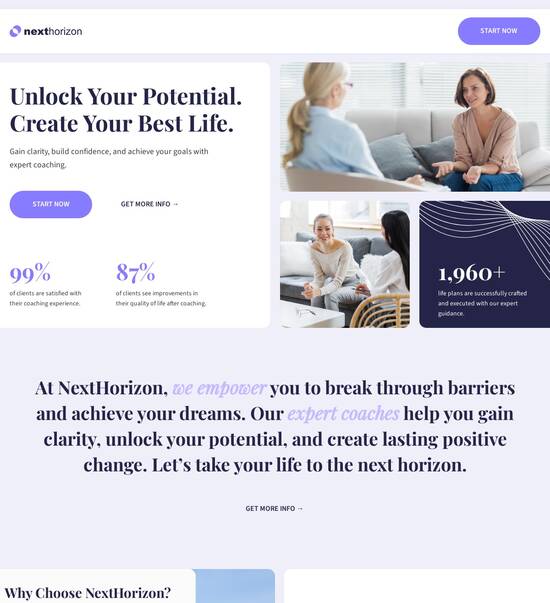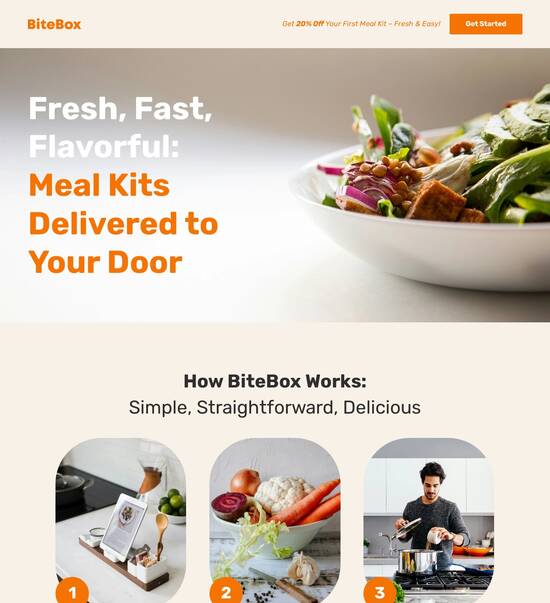
Next.js optimized shopping cart page template
Explore Similar TemplatesAbout template
Supercharge your shopping cart page with Next.js for outstanding performance! Learn more today.
Recommended templates

Easy to build without coding
With the intuitive drag-and-drop builder, anyone on your team can create high-converting pages without any knowledge of code or design. Make enhancements to your landing page with custom widgets using Javascript, HTML/CSS, or third-party scripts.

Multiple layouts for any industry and goal
Select from 500+ landing page layouts built to boost conversions across industry-specific scenarios. Customize them by adjusting fonts, adding images, and generating on-brand content with the AI assistant. Quickly scale with Instablocks® and Global Blocks that you can save, reuse, and update globally.

Loads fast and looks polished on any device
Every template is responsive, which means they present professionally on any device and load blazingly fast with our Thor Render Engine. You can also power them up with Google AMP technology to deliver an unparalleled mobile experience and drive higher conversions.

Robust analytics & experimentation
Get real-time updates and reporting across all your devices, showing the number of visitors, conversions, cost-per-visitor, and cost-per-lead. Launch AI-powered experiments, run A/B tests, and use heatmaps to analyze user behavior, then optimize your landing page to maximize conversions.







Easy to build without coding
With the intuitive drag-and-drop builder, anyone on your team can create high-converting pages without any knowledge of code or design. Make enhancements to your landing page with custom widgets using Javascript, HTML/CSS, or third-party scripts.
Multiple layouts for any industry and goal
Select from 500+ landing page layouts built to boost conversions across industry-specific scenarios. Customize them by adjusting fonts, adding images, and generating on-brand content with the AI assistant. Quickly scale with Instablocks® and Global Blocks that you can save, reuse, and update globally.
Loads fast and looks polished on any device
Every template is responsive, which means they present professionally on any device and load blazingly fast with our Thor Render Engine.
Robust analytics & experimentation
Get real-time updates and reporting across all your devices, showing the number of visitors, conversions, cost-per-visitor, and cost-per-lead. Launch AI-powered experiments, run A/B tests, and use heatmaps to analyze user behavior, then optimize your landing page to maximize conversions.
All the features you need to build html shopping cart template free download
Explore more featuresLearn how to build shopping cart html template free
Frequently asked questions about free html shopping cart template
Leading the way in building high-performing landing pages





Html shopping cart template: Your ultimate how-to guide
Instapage stands out as the leading solution for marketers looking to enhance their online campaigns. By providing a comprehensive suite of tools designed for landing page creation and conversion rate optimization, Instapage helps you easily launch high-impact campaigns that resonate with your target audience, from business services to educational institutions.
Getting started with Instapage
First, familiarize yourself with the intuitive layout of the platform. You can dive right into creating your landing pages with the available templates. Take the time to explore the features that allow for quick adjustments and customization, ensuring your pages reflect your branding and messaging effectively.
- Choose from over 100 templates: Instapage offers a library of high-converting templates that cater to various industries, making it easy for marketers to find a starting point.
- Utilize pre-built lead generation elements: Use forms, buttons, and other interactive elements to maximize engagement and capture leads instantly.
- Experience a flexible page creation platform: Benefit from the drag-and-drop functionality that requires no coding skills, allowing for rapid development and deployment.
Optimizing landing pages for higher conversions
Effective optimization is crucial to achieving your campaign goals. Instapage provides a range of built-in tools that help you refine your pages by analyzing data-driven insights.
Implementing A/B testing and analytics
A/B testing is essential for understanding what variations of your pages perform best. The following steps will guide you through using Instapage’s built-in A/B testing functionalities.
- Set clear goals: Define what success looks like for your campaign—be it lead submissions or user sign-ups.
- Create variations: Use the easy-to-modify templates to create different versions of your page and track their performance.
- Analyze results: Review the analytics dashboard to measure the performance of each version, enabling informed decisions for future campaigns.
Personalizing the user experience
Personalization elevates user engagement and increases conversions. Instapage’s dynamic text replacement and audience segmentation tools allow you to cater your messaging according to your visitor's profile.
- Utilize dynamic text replacement: Automatically adjust text based on the user's source to create a tailored experience.
- Implement AdMaps for ad alignment: Ensure that your ads correspond directly to dedicated landing pages for improved continuity.
- Track audience metrics: Monitor how different segments of your audience interact with your content to refine targeting strategies.
By leveraging these strategies, you can fully utilize Instapage to accelerate your campaign performance and maximize your ROI.
Ready to transform your marketing efforts? Start your trial with Instapage today to access powerful features that can take your campaigns to the next level.
Next.js optimized shopping cart page template
Understanding Next.js: A powerful framework for building shopping cart applications
Next.js is a React-based framework that offers an array of features aimed at improving the development experience and performance of web applications. Its robust capabilities include server-side rendering, static site generation, and seamless routing, making it a favored choice for developers aiming to create efficient and scalable eCommerce applications. Next.js provides an excellent platform for building shopping cart pages that deliver optimal performance and user experience.
What sets Next.js apart for eCommerce applications is its ability to generate static pages that load incredibly fast, paired with dynamic rendering for real-time updates such as cart modifications. With Next.js, developers can combine the best of both worlds—static content for performance and dynamic content for interactivity. This makes it simpler to build responsive shopping cart pages that can handle high traffic while still providing a seamless user experience.
Built-in performance optimization
API routes for backend integration
Automatic code splitting to enhance loading speed
Key components of an optimized shopping cart page
A well-designed shopping cart page focuses on essential components that help users navigate their purchase journey with ease. Key UI elements such as item displays, quantity selectors, and total price calculations are critical for delivering a smooth checkout experience. Optimizing these components contributes to a better user experience, as they ensure that customers can quickly modify their selections and view updated prices instantly.
In addition to essential UI components, responsiveness is crucial when developing a shopping cart page. This means ensuring that the layout looks good and functions well on various devices, from desktops to smartphones. Modern CSS frameworks can aid in creating a responsive design, but developers must also pay close attention to how components render across different screen sizes.
Item display area for presenting products
Quantity selector to adjust item amounts
Total price calculation feature
Next.js also offers an efficient component lifecycle for managing these UI elements. Understanding how components render and update in response to user interactions ensures that state management is handled correctly. By utilizing hooks like useState and useEffect, developers can manage component states effectively, allowing for real-time cart functionality.
Setting up your Next.js project for a shopping cart
To get started with your Next.js shopping cart application, you need to create a well-structured project. The directory layout is fundamental, as it organizes your files in a way that makes development and maintenance easy. Typically, the structure should include directories for pages, components, and potentially services for API connections. Organizing your project this way will save time in the long run and improve collaboration within your development team.
Use intuitive naming conventions for your files and components to simplify navigation and enhance readability. Component files might be named after their function, such as CartItem.js and CartSummary.js, lending clarity to their purposes within the application. These conventions should extend to your CSS files and service layers as well, promoting a clean and maintainable codebase.
Create directories for pages, components, and styles
Use descriptive names for components and files
Keep a separate folder for any services like API integrations
After structuring your files, initialize a Git repository for version control. Creating a repository enables you to track changes and collaborate more effectively within a development team. Use best practices, such as committing frequently with clear messages and creating meaningful branches, to keep your codebase organized as your project expands.
Building the shopping cart components
Creating reusable components is essential for efficient development, especially for a shopping cart. Key components include CartItem, CartSummary, and CartButton. These components can be designed once and reused throughout the application, ensuring consistency and reducing redundancy. For instance, a CartItem component can encapsulate the logic for displaying individual product data, which might include the product image, name, price, and remove button.
Integrating these components with a backend API enables dynamic retrieval and manipulation of product and cart data. When a user adds a product, a request can be sent to the server to update the cart information accordingly. This allows for a seamless shopping experience where product availability and user adjustments can be reflected in real-time. Below is a simple illustration of how the CartItem component can be structured:
CartItem.js: Displays product details and a button to remove the item
CartSummary.js: Show total price and a checkout button
CartButton.js: Improves interactivity for adding/removing items
Connecting to a backend API for product retrieval is vital. Utilize modern tools such as Axios or Fetch to make API calls that pull in product details. The add/remove functionality can be implemented through corresponding API endpoints. Here's a brief code snippet to illustrate how to fetch cart data:
Developing the shopping cart page
Once the individual components are created, the next step is to bring them together into a comprehensive shopping cart page. In Next.js, this can be done by creating a new file in the 'pages' directory named shoppingCart.js. This file serves as the main component for your shopping cart experience, allowing you to import and use the components you've previously developed.
A step-by-step guide for implementing your shopping cart page should include importing your newly created components, assembling them into a cohesive layout, and incorporating state management for dynamic functionality. Here’s a simplified outline of what to include in your shoppingCart.js file:
Import CartItem, CartSummary, and CartButton components
Use React hooks to manage cart state
Render components within your main ShoppingCart functional component
Incorporate the developers' best practices to ensure your code is clean and maintainable. Use meaningful prop names and leave comments where necessary. This not only benefits you as the developer but also anyone else who may work on the project in the future.
Optimizing performance for the shopping cart page
One of the standout features of Next.js is its optimization capabilities. Leveraging static generation and server-side rendering can significantly enhance performance for shopping cart pages. By utilizing functions like getStaticProps and getServerSideProps, data fetching can be optimized based on user traffic patterns or content changes, improving loading times and user experience.
Using getStaticProps allows you to pre-render static pages at build time, while getServerSideProps fetches data on each request. This flexibility means you can serve pages that are dynamic for user-specific data, such as cart contents, while also caching static page data for improved load speeds.
Utilize getStaticProps for static data fetching
Implement getServerSideProps for dynamic requests
Analyze user traffic to decide optimization strategies
Reducing load time also involves efficient code splitting. Next.js does this automatically with its page-based routing, ensuring that only the necessary code is loaded for a given page. Developers can further optimize bundle sizes by eliminating unused dependencies and using dynamic imports where applicable. This helps maintain snappy page interactions, crucial for retaining customer interest on shopping cart pages.
Enhancing user experience and accessibility
User experience (UX) is paramount for shopping cart success. Focusing on intuitive navigation can streamline how users interact with the shopping cart, reducing friction during the checkout process. Options like providing instant feedback on cart updates, incorporating loading states, and displaying notifications for successful actions contribute positively to UX.
To further enhance accessibility, following established standards such as the Web Content Accessibility Guidelines (WCAG) is essential. Implementing proper ARIA attributes within components ensures that your application is accessible to users with disabilities, thus broadening your audience reach. For instance, labels for inputs and notifications should be coded correctly, improving the usability of the shopping cart for assistive technologies.
Focus on intuitive navigation within the shopping cart
Implement user feedback mechanisms (loading states, notifications)
Adhere to WCAG standards for accessibility
Regularly test your shopping cart's accessibility features to identify and rectify issues. Tools like axe and Wave can automate accessibility checks to corroborate compliance. By prioritizing accessibility, you not only cater to a wider audience but also fulfill ethical responsibilities as a developer.
Addressing common challenges and learning curves
Building shopping cart applications in Next.js can come with its own set of challenges. Developers need to navigate common development pitfalls such as state management issues, where improper use of hooks could lead to unexpected unforeseen behaviors. Clear documentation and examples from the Next.js community can help alleviate these concerns.
Furthermore, new developers may face a learning curve as they familiarize themselves with Next.js features and component structures. Leveraging resources like the official Next.js documentation, community forums, and platforms offering courses can assist in quickly building proficiency. Understanding foundational concepts in React also enhances the learning experience, enabling new developers to tackle more advanced topics with confidence.
Identify common errors and best practices for solutions
Engage with community resources for support
Master foundational React concepts to streamline Next.js development
Future-proofing your shopping cart application
To ensure your shopping cart application continues to meet evolving eCommerce needs, adaptability is crucial. You'll want to implement scalable solutions and updates as your business requirements shift. Methods for future-proofing could include modularizing components so new features can be added seamlessly, or integrating headless CMSs for managing changing product information.
Staying informed about the latest Next.js features and community trends is also beneficial. Regularly reviewing the Next.js release notes and engaging with forums can keep your knowledge current. Additionally, exploring integration with payment gateways ultimately enhances your shopping cart, enabling secure and convenient transactions.
Implement modular components for easy updates
Explore headless CMS integrations for product management
Stay updated with community trends and Next.js releases
Integrating secure payment processing options like Stripe or PayPal can enhance user trust during checkout. Implementing these payment gateways requires careful attention to security and compliance, including PCI-DSS standards, to protect customer information.
Real-world use cases: successful shopping cart implementations
Examining real-world use cases provides valuable insights into effective shopping cart designs and implementations. Many successful eCommerce sites utilize Next.js to enhance user engagement and streamline purchase processes. By analyzing these sites, one can glean ideas for unique features that could boost user experience and conversion rates.
For example, an effective use case might include implementing features like abandoned cart notifications or wish list functionalities. These can encourage customer return visits and increase the chances of conversions by keeping the brand top-of-mind.
Successful brands using Next.js for optimized shopping carts
Analysis of features enhancing user engagement
Importance of A/B testing in refining cart design
Utilizing A/B testing allows you to measure the effectiveness of different design elements and user flows within the shopping cart. By gathering user feedback and analytics, you can make informed decisions on updates that improve conversion rates, optimizing your overall eCommerce strategy.
Conclusion: empowering eCommerce with Next.js shopping cart templates
In conclusion, Next.js presents a powerful toolkit for those looking to create highly optimized shopping cart applications. The framework's ability to handle both static and dynamic content efficiently improves user experience and boosts overall performance. The modular approach to component development fosters maintainable and scalable applications, essential in today’s competitive eCommerce landscape.
As eCommerce continues to evolve, so do the technologies supporting it. By leveraging Next.js, you can stay ahead of the curve, adapt to changing market demands, and deliver exceptional online shopping experiences that increase brand trust and customer loyalty. Whether you're just starting or looking to enhance an existing application, Next.js offers unique advantages that empower your development.
Ready to skyrocket conversions?
Supercharge your ad campaigns with high-performing landing pages
Get started














